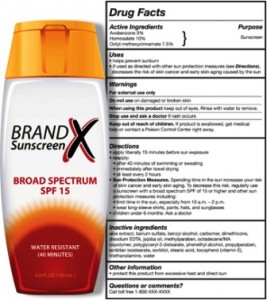New Sunscreen Regulations Should Provide More Accurate Information to Consumers of Sun
Next summer, sunscreen bottles will be seeing many changes as a result of new federal regulations announced on June 14. The regulations were created to ensure that sunscreens meet modern standards for safety and effectiveness.
For the first time ever, sunscreen labels that pass FDA approved testing will be able to claim they can reduce the risk of skin cancer and early skin aging, in addition to preventing sunburn. In order to pass this requirement, sunscreens must be proven to be “broad spectrum” — meaning they protect against both ultraviolet A and ultraviolet B radiation and have a sunburn protection factor of 15 or higher. Those that do not meet both criteria will carry a warning label indicating that they have not been shown to help prevent skin cancer or early skin aging.
Effect on terms “waterproof,” “sweatproof,” & “sunblock”
The FDA will forbid these terms from being included on labels because they are considered inaccurate. Sunscreens will be able to claim water resistance based on testing, but they must note whether they are effective for 40 minutes or 80 minutes while swimming or sweating. Sunscreens will now also carry drug fact labels like those that you see on an over-the-counter medication box.
What about those SPF 100 sunscreens?
The FDA has proposed to limit the maximum SPF to “50+” since there is insufficient, reliable evidence that higher values, such as 70 or 100, provide greater protection. Some experts hope this will stop the “escalating war of SPF factors.”
Dr. Warwick L. Morison, a professor of dermatology at Johns Hopkins University and chairman of the photobiology committee for the Skin Cancer Foundation, was disappointed the FDA did not ban the products that contained SPF numbers higher than 50 because such products expose people to more irritating sunscreen ingredients without meaningful added protection.
Some thoughts from the experts:
- There is really no difference between 50 or 70 or 80 SPF designations.
- If you apply the proper amount of sunscreen, with frequent reapplication, you really do not need an SPF that is above 30.
- The amount that should be applied is equivalent to a shot glass full, but on average, people apply only about half that amount.
- Make sure you are re-applying often enough; particularly after swimming.
Concern over sunscreen ingredients
Kelly McMasters, director of the James Graham Brown Cancer Center’s melanoma clinic, is concerned that the agency did not go far enough in addressing safety concerns about some sunscreen ingredients. For example, some sunscreens may include endocrine disruptors, such as oxybenzone, which may interfere with certain hormones and pregnant women may want to avoid retinyl palmitate because of possible negative effects. Moreover, zinc oxide and titanium dioxide nanoparticles might have potential reproductive and developmental effects. The FDA is awaiting the results of new studies to determine whether retinyl palmitate is harmful.
Bottom Line
Excessive sun exposure is the most important preventable cause of all skin cancers, including potentially deadly melanoma. If you would like to view a list of the best beach and sport sunscreens, the environmental working group has an excellent list –available here.
What else can you do to avoid the potentially harmful effects of the sun:
- Wear broad-brimmed hats.
- Cover up with clothing to protect skin—the tighter the weave and the darker the color, the better the SPF protection.
- Avoid sun exposure especially during the hours of 10 a.m. and 4 p.m.
- Be aware that reflective surfaces like water, sand and cars increase chances of sunburns.
- You can still burn on cloudy days. Since UV rays are still strong enough to burn your skin.
- Rinse off when coming indoors or at the end of the day.
- Children’s skin is delicate and can be damaged in as little as 15 minutes of unprotected sun exposure. It takes 15 minutes to see initial effects of exposure, but 12 hours before the whole burn effect to be realized.
- Wear sunglasses that protect against UVA and UVB rays. The rays of the sun can damage eyes; causing cataracts and acceleration of age related vision loss.
As a citizen of the sunshine state, make sure you and your loved ones are lathering up before playing or working in the sun!
Share This



